英语论文写作——如何引用
- 格式:ppt
- 大小:611.00 KB
- 文档页数:44
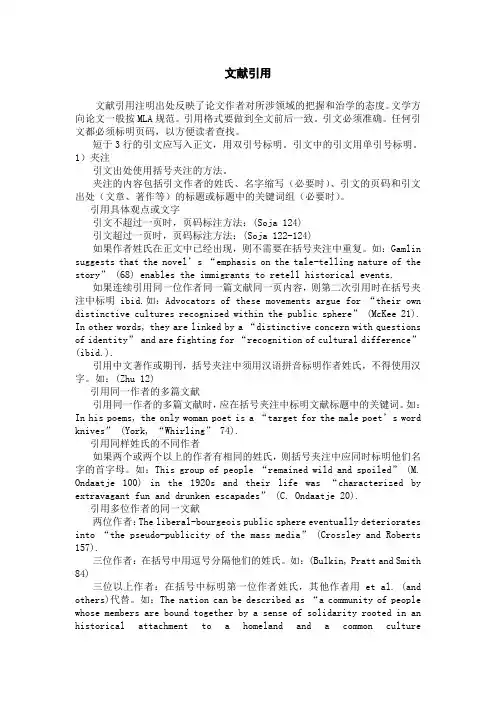
文献引用文献引用注明出处反映了论文作者对所涉领域的把握和治学的态度。
文学方向论文一般按MLA规范。
引用格式要做到全文前后一致。
引文必须准确。
任何引文都必须标明页码,以方便读者查找。
短于3行的引文应写入正文,用双引号标明。
引文中的引文用单引号标明。
1)夹注引文出处使用括号夹注的方法。
夹注的内容包括引文作者的姓氏、名字缩写(必要时)、引文的页码和引文出处(文章、著作等)的标题或标题中的关键词组(必要时)。
引用具体观点或文字引文不超过一页时,页码标注方法:(Soja 124)引文超过一页时,页码标注方法:(Soja 122-124)如果作者姓氏在正文中已经出现,则不需要在括号夹注中重复。
如:Gamlin suggests that the novel’s “emphasis on the tale-telling nature of the story” (68) enables the immigrants to retell historical events.如果连续引用同一位作者同一篇文献同一页内容,则第二次引用时在括号夹注中标明ibid.如:Advocators of these movements argue for “their own distinctive cultures recognized within the public sphere” (McKee 21). In other words, they are linked by a “distinctive concern with questions of identity”and are fighting for “recognition of cultural difference”(ibid.).引用中文著作或期刊,括号夹注中须用汉语拼音标明作者姓氏,不得使用汉字。
如:(Zhu 12)引用同一作者的多篇文献引用同一作者的多篇文献时,应在括号夹注中标明文献标题中的关键词。
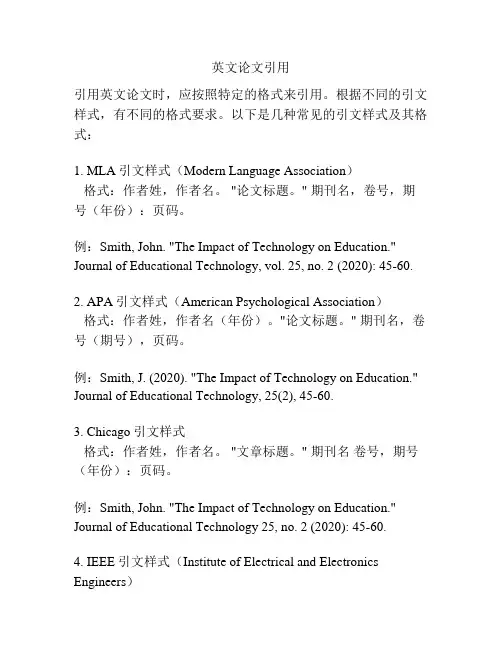
英文论文引用引用英文论文时,应按照特定的格式来引用。
根据不同的引文样式,有不同的格式要求。
以下是几种常见的引文样式及其格式:1. MLA引文样式(Modern Language Association)格式:作者姓,作者名。
"论文标题。
" 期刊名,卷号,期号(年份):页码。
例:Smith, John. "The Impact of Technology on Education." Journal of Educational Technology, vol. 25, no. 2 (2020): 45-60.2. APA引文样式(American Psychological Association)格式:作者姓,作者名(年份)。
"论文标题。
" 期刊名,卷号(期号),页码。
例:Smith, J. (2020). "The Impact of Technology on Education." Journal of Educational Technology, 25(2), 45-60.3. Chicago引文样式格式:作者姓,作者名。
"文章标题。
" 期刊名卷号,期号(年份):页码。
例:Smith, John. "The Impact of Technology on Education." Journal of Educational Technology 25, no. 2 (2020): 45-60.4. IEEE引文样式(Institute of Electrical and Electronics Engineers)格式:[数字] 作者姓,作者名,"论文标题",期刊名,卷号,期号,页码,年份。
例:[1] J. Smith, "The Impact of Technology on Education." Journal of Educational Technology, vol. 25, no. 2, pp. 45-60, 2020.请注意,不同学术领域及期刊可能会有不同的引文样式要求,因此在引用时最好查阅所写作的期刊的引文准则以确保格式的正确性。

英文文献的引用方法与格式一、引用的重要性引用英文文献首先是学术道德的要求。
通过引用,我们承认前人的工作和贡献,避免抄袭和剽窃。
其次,引用能够为我们的研究提供背景和依据,展示我们对该领域已有研究的了解程度。
此外,合理的引用还可以增加我们文章的可信度和权威性,使读者更容易接受我们的观点。
二、常见的引用格式1、 APA 格式APA(American Psychological Association)格式是社会科学领域中常用的引用格式。
在文中引用时,通常采用作者姓氏和出版年份的方式,如(Smith, 2010)。
如果直接引用,还需要注明页码,如(Smith, 2010, p 25)。
在参考文献列表中,书籍的格式为:作者姓氏,名字首字母(出版年份)书名出版地:出版社。
期刊文章的格式为:作者姓氏,名字首字母(出版年份)文章标题期刊名,卷号(期号),起止页码。
2、 MLA 格式MLA(Modern Language Association)格式主要用于人文领域。
文中引用的格式为作者姓氏和页码,如(Smith 25)。
参考文献列表中,书籍的格式为:作者姓氏,名字书名出版社,出版年份。
期刊文章的格式为:作者姓氏,名字“文章标题” 期刊名卷号期号(出版年份):起止页码。
3、 Chicago 格式Chicago 格式在历史、艺术等领域较为常见。
文中引用有两种方式,脚注或尾注。
在参考文献列表中,书籍的格式根据具体情况有所不同,常见的为:作者姓氏,名字书名出版地:出版社,出版年份。
期刊文章的格式为:作者姓氏,名字“文章标题” 期刊名卷号期号(出版年份):起止页码。
三、引用的类型1、直接引用直接引用是将原文的内容一字不差地引用过来,并使用引号标注。
直接引用通常用于原文的表述非常精彩、独特或者具有权威性。
2、间接引用间接引用是对原文的意思进行概括和转述,不需要使用引号。
在间接引用时,要确保准确传达原文的主要观点。
四、电子资源的引用随着互联网的发展,电子资源如在线文章、电子书、数据库等在学术研究中的使用越来越普遍。
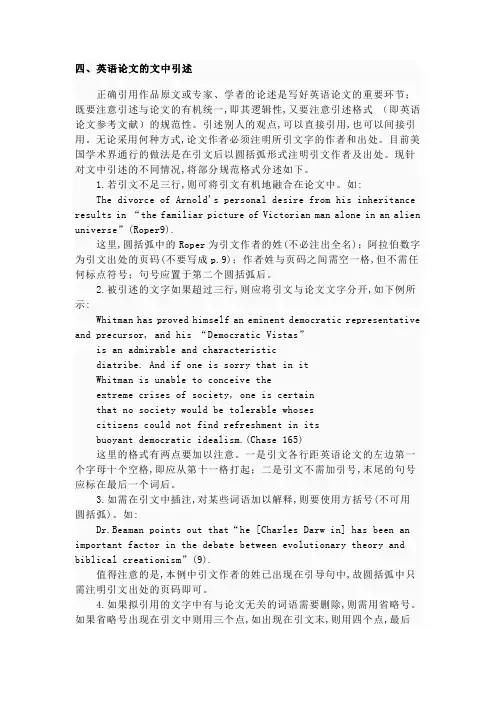
四、英语论文的文中引述正确引用作品原文或专家、学者的论述是写好英语论文的重要环节;既要注意引述与论文的有机统一,即其逻辑性,又要注意引述格式(即英语论文参考文献)的规范性。
引述别人的观点,可以直接引用,也可以间接引用。
无论采用何种方式,论文作者必须注明所引文字的作者和出处。
目前美国学术界通行的做法是在引文后以圆括弧形式注明引文作者及出处。
现针对文中引述的不同情况,将部分规范格式分述如下。
1.若引文不足三行,则可将引文有机地融合在论文中。
如:The divorce of Arnold's personal desire from his inheritance results in “the familiar picture of Victorian man alone in an alien universe”(Roper9).这里,圆括弧中的Roper为引文作者的姓(不必注出全名);阿拉伯数字为引文出处的页码(不要写成p.9);作者姓与页码之间需空一格,但不需任何标点符号;句号应置于第二个圆括弧后。
2.被引述的文字如果超过三行,则应将引文与论文文字分开,如下例所示:Whitman has proved himself an eminent democratic representative and precursor, and his “Democratic Vistas”is an admirable and characteristicdiatribe. And if one is sorry that in itWhitman is unable to conceive theextreme crises of society, one is certainthat no society would be tolerable whosescitizens could not find refreshment in itsbuoyant democratic idealism.(Chase 165)这里的格式有两点要加以注意。

英语论⽂引⽤格式规范英语论⽂的⽂中引述正确引⽤作品原⽂或专家、学者的论述是写好英语论⽂的重要环节;既要注意引述与论⽂的有机统⼀,即其逻辑性,⼜要注意引述格式(即英语论⽂参考⽂献)的规范性。
引述别⼈的观点,可以直接引⽤,也可以间接引⽤。
⽆论采⽤何种⽅式,论⽂作者必须注明所引⽂字的作者和出处。
⽬前美国学术界通⾏的做法是在引⽂后以圆括弧形式注明引⽂作者及出处。
现针对⽂中引述的不同情况,将部分规范格式分述如下。
1.若引⽂不⾜三⾏,则可将引⽂有机地融合在论⽂中。
如:The divorce of Arnold's pe rsonal desire from his inheritance results in “the familiar picture of Victorian man alone in an alien universe”(Roper 9).这⾥,圆括弧中的Roper为引⽂作者的姓(不必注出全名);阿拉伯数字为引⽂出处的页码(不要写成p.9);作者姓与页码之间需空⼀格,但不需任何标点符号;句号应置于第⼆个圆括弧后。
2.被引述的⽂字如果超过三⾏,则应将引⽂与论⽂⽂字分开,如下例所⽰:Whitman has proved himself an eminent democratic representativeand precursor, and his “Democratic Vistas” is an admirable andcharacteristic diatribe. And if one is sorry that in it Whitman isunable to conceive the extreme crises of society, one is certain thatno society would be tolerable whose citizens could not findrefreshment in its buoyant democratic idealism.(Chase 165) 这⾥的格式有两点要加以注意。
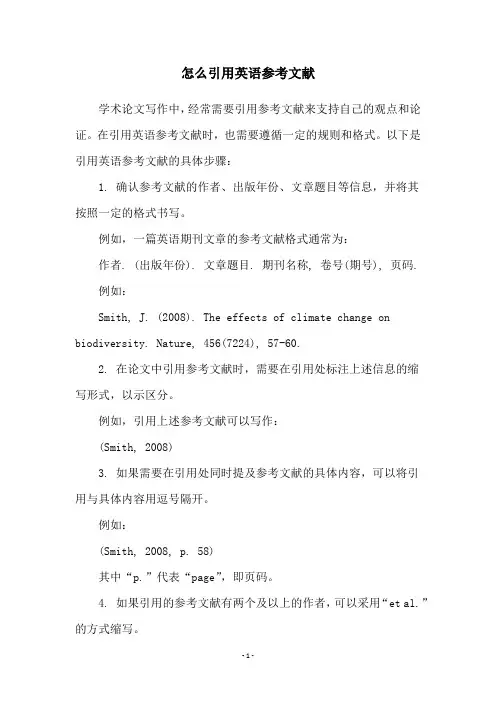
怎么引用英语参考文献
学术论文写作中,经常需要引用参考文献来支持自己的观点和论证。
在引用英语参考文献时,也需要遵循一定的规则和格式。
以下是引用英语参考文献的具体步骤:
1. 确认参考文献的作者、出版年份、文章题目等信息,并将其
按照一定的格式书写。
例如,一篇英语期刊文章的参考文献格式通常为:
作者. (出版年份). 文章题目. 期刊名称, 卷号(期号), 页码.
例如:
Smith, J. (2008). The effects of climate change on biodiversity. Nature, 456(7224), 57-60.
2. 在论文中引用参考文献时,需要在引用处标注上述信息的缩
写形式,以示区分。
例如,引用上述参考文献可以写作:
(Smith, 2008)
3. 如果需要在引用处同时提及参考文献的具体内容,可以将引
用与具体内容用逗号隔开。
例如:
(Smith, 2008, p. 58)
其中“p.”代表“page”,即页码。
4. 如果引用的参考文献有两个及以上的作者,可以采用“et al.”的方式缩写。
例如:
(Smith et al., 2008)
其中“et al.”代表“and others”,即“等人”。
总之,在引用英语参考文献时,需要注意书写格式和标注方式,以确保准确、清晰地表达自己的论点和观点。

英文文献的引用方法与格式一、引用的重要性引用英文文献首先有助于增强您研究的可信度和说服力。
通过引用权威的、相关的文献,您可以表明自己的研究是建立在前人的基础之上,并非凭空想象。
其次,引用能够展示您对该领域已有研究的了解程度,反映出您在学术研究中的深入程度和专业素养。
此外,恰当的引用还可以避免抄袭的嫌疑,保障学术的公正性和纯洁性。
二、常见的引用格式1、 APA 格式APA(American Psychological Association)格式是社会科学领域中常用的引用格式。
在正文中,引用一般采用作者姓氏和出版年份的方式,如(Smith, 2010)。
如果直接引用,还需要注明页码,如(Smith, 2010, p 25)。
在参考文献列表中,书籍的格式通常为:作者姓氏,名字首字母(出版年份)书名出版地:出版社。
例如:Smith, J D (2010) The history of psychology New York: Wiley期刊文章的格式为:作者姓氏,名字首字母(出版年份)文章标题期刊名,卷号(期号),起止页码。
例如:Johnson, M T (2015) The impact of technology on education Journal of Educational Technology, 25(2), 120-135、2、 MLA 格式MLA(Modern Language Association)格式常用于人文领域。
在正文中,引用采用作者姓氏和页码的方式,如(Smith 25)。
参考文献列表中,书籍的格式为:作者姓氏,名字书名出版社,出版年份。
例如:Smith, John The Art of Writing Penguin, 2012、期刊文章的格式为:作者姓氏,名字“文章标题” 期刊名卷号,期号(出版年份):起止页码。
例如:Johnson, Mary “The Future of Literature” English Journal 55, no 3 (2015): 45-55、3、 Chicago 格式Chicago 格式有两种常见的引用方式:脚注/尾注格式和作者日期格式。
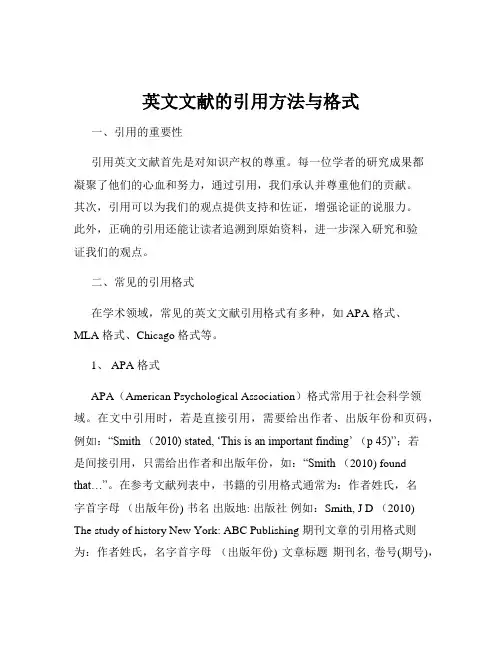
英文文献的引用方法与格式一、引用的重要性引用英文文献首先是对知识产权的尊重。
每一位学者的研究成果都凝聚了他们的心血和努力,通过引用,我们承认并尊重他们的贡献。
其次,引用可以为我们的观点提供支持和佐证,增强论证的说服力。
此外,正确的引用还能让读者追溯到原始资料,进一步深入研究和验证我们的观点。
二、常见的引用格式在学术领域,常见的英文文献引用格式有多种,如 APA 格式、MLA 格式、Chicago 格式等。
1、 APA 格式APA(American Psychological Association)格式常用于社会科学领域。
在文中引用时,若是直接引用,需要给出作者、出版年份和页码,例如:“Smith (2010) stated, ‘This is an important finding’ (p 45)”;若是间接引用,只需给出作者和出版年份,如:“Smith (2010) found that…”。
在参考文献列表中,书籍的引用格式通常为:作者姓氏,名字首字母(出版年份) 书名出版地: 出版社例如:Smith, J D (2010) The study of history New York: ABC Publishing 期刊文章的引用格式则为:作者姓氏,名字首字母(出版年份) 文章标题期刊名, 卷号(期号),起止页码例如:Johnson, M A (2015) New research on climate change Science Journal, 25(2), 56-78、2、 MLA 格式MLA(Modern Language Association)格式主要用于人文科学领域。
在文中引用时,若是直接引用,格式为:“‘This is an important finding’ (Smith 45)”;间接引用则为:“Smith claims…”。
在参考文献列表中,书籍的引用格式为:作者姓氏,名字书名出版地: 出版社, 出版年份比如:Smith, John The History Book New York: Penguin, 2012、期刊文章的引用格式是:作者姓氏,名字“文章标题” 期刊名卷号期号(出版年份):起止页码例如:Johnson, Mary “Research on Literature” Academic Journal 153 (2018): 78-90、3、 Chicago 格式Chicago 格式常用于历史和艺术领域。
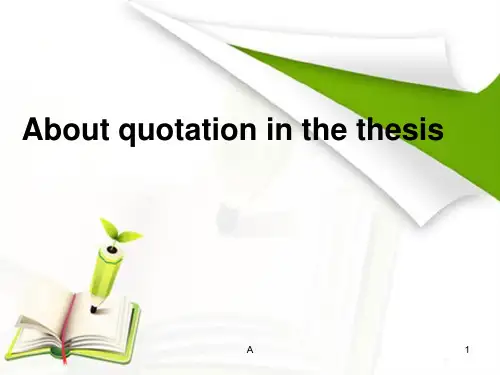
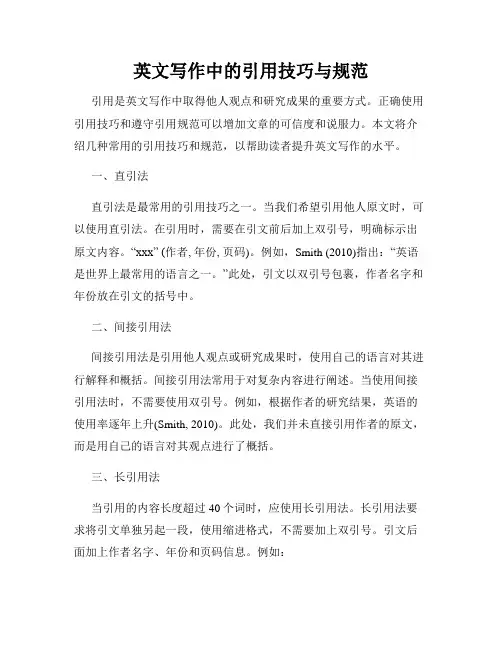
英文写作中的引用技巧与规范引用是英文写作中取得他人观点和研究成果的重要方式。
正确使用引用技巧和遵守引用规范可以增加文章的可信度和说服力。
本文将介绍几种常用的引用技巧和规范,以帮助读者提升英文写作的水平。
一、直引法直引法是最常用的引用技巧之一。
当我们希望引用他人原文时,可以使用直引法。
在引用时,需要在引文前后加上双引号,明确标示出原文内容。
“xxx” (作者, 年份, 页码)。
例如,Smith (2010)指出:“英语是世界上最常用的语言之一。
”此处,引文以双引号包裹,作者名字和年份放在引文的括号中。
二、间接引用法间接引用法是引用他人观点或研究成果时,使用自己的语言对其进行解释和概括。
间接引用法常用于对复杂内容进行阐述。
当使用间接引用法时,不需要使用双引号。
例如,根据作者的研究结果,英语的使用率逐年上升(Smith, 2010)。
此处,我们并未直接引用作者的原文,而是用自己的语言对其观点进行了概括。
三、长引用法当引用的内容长度超过40个词时,应使用长引用法。
长引用法要求将引文单独另起一段,使用缩进格式,不需要加上双引号。
引文后面加上作者名字、年份和页码信息。
例如:The research indicates that "English has become a global language, with over 1.5 billion people around the world learning it as a second language" (Smith, 2010, p. 25).四、引用规范在进行英文写作中,除了使用正确的引用技巧外,还需要遵守引用规范。
以下是一些常见的引用规范要求:1.在引文中标注作者名字、年份和页码信息。
这样可以方便读者查找原文,了解引用的来源。
2.在引文后的参考文献中,按照特定格式列出引用的书籍、期刊、网页等信息。
不同学术领域有不同的引用格式要求,例如APA、MLA 等。
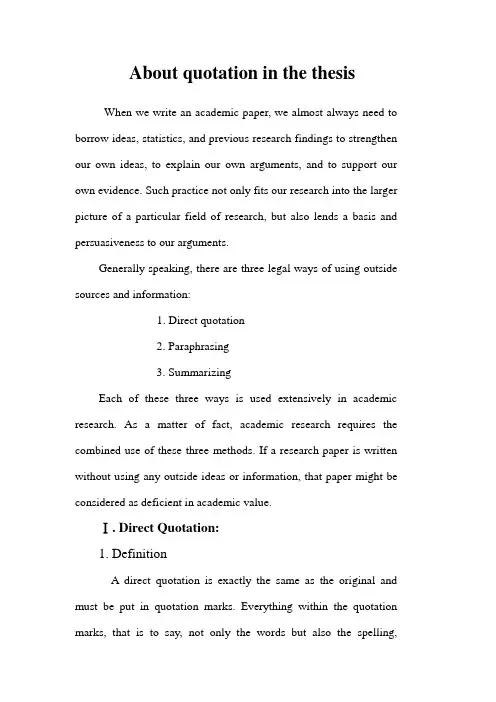
About quotation in the thesis When we write an academic paper, we almost always need to borrow ideas, statistics, and previous research findings to strengthen our own ideas, to explain our own arguments, and to support our own evidence. Such practice not only fits our research into the larger picture of a particular field of research, but also lends a basis and persuasiveness to our arguments.Generally speaking, there are three legal ways of using outside sources and information:1. Direct quotation2. Paraphrasing3. SummarizingEach of these three ways is used extensively in academic research. As a matter of fact, academic research requires the combined use of these three methods. If a research paper is written without using any outside ideas or information, that paper might be considered as deficient in academic value.Ⅰ. Direct Quotation:1. DefinitionA direct quotation is exactly the same as the original and must be put in quotation marks. Everything within the quotation marks, that is to say, not only the words but also the spelling,capitalization and interior punctuation, should be exactly the same as the original.2. When to use direct quotations(1) When the original wording expresses the idea so preciselyand succinctly that we cannot improve on it;(2) When the direct quotation comes from an authority in aparticular field and therefore strengthens our point ofview;(3) When we need to borrow a special term or expression that isa particular writer’s invention and carries special meanin g;(4) When we need the original wording for the purpose offurther discussion.3. How to use direct quotation(1) When we do quote, we should make every effort to workthe direct quotation into our own statement so that it maybecome part of an organic whole.(2) Use a colon if our direct quotation is introduced by acomplete sentence:Sample 1Sinclair Lewis, the first American Nobel Prize winner for literature in 1930, believed that Dreiser better deserved the prize: “D reiser…more than any other man, marching alone,usually unappreciated, often hated, has cleared the trail from Victorian and Howellsian timidity and gentility in the American fiction to honesty, boldness and passion of life.”(3) Treat the direct quotation as part of the sentence andpunctuate accordingly if it is not introduced by a completesentence:Sample 2To Sinclair Lewis, “Dreiser…more than any other man, marching alone, usually unappreciated, often hated, has cleared the trail from Victorian and Howellsian timidity and gentility in the American fiction to honesty, boldness and passion of life.”ExerciseI have a dream that my four little children will one daylive in a nation where they will not be judged by the color of their skin but by the content of their character.From “I have a dream…”, a speech by Martin Luther King, Jr.4. We should observe the following rules when using directquotation:(1). Keep the quotation as brief as possible;(2).Be accurate. What appears between quotation marks should beexactly the same as the original. No word, punctuation, or even spelling should be charged;(3). Always indicate the source of the quotation;(4). When the quotation is less than three lines, incorporate it inthe flow of the paragraph with a pair of quotation marks.When the quotation is longer than three lines, use a separate and indented paragraph, without quotation marks, to indicate the quotation;Eg:The view that writing is typically a socially-situated act has been reinforced by the aims and experiences of the recent Writing Across the Curriculum (WAC) movement (Young and Fulwiler, 1986). A primary research agenda for W AC has been firmly laid out by Faigley and Hansen:If teacher of English are to offer courses that truly prepare students to write in other disciplines, they will haveto explore why those disciplines study certain subjects,why certain methods of enquiry are sanctioned, how theconvertions of a discipline shape a text in that discipline,how individual writers represent themselves in the text,how a text is read and disseminated, and how one textinfluences subsequent texts.(Faigley and Hansen, 1985:149)(5). When only parts of a long sentence or passage are quoted, theomitted words may be indicated three dots. However, the parts that do appear as a quotation still have to be accurate; (6). The volume of direct quotations in any piece of academicwriting should be kept within10~20﹪of the total paper length. Too much quoted material may spoil the originality or style of the academic paper.5. The following expressions are often used to indicate the sourceof a direct quotation. It is often advisable to include when and where the person said so.As X said… As X reported…As X stated… As X wrote…As X mentioned… As X maintained…As X insisted… As X declared…X said… X further stated…X later insisted… X continued…X firmly believed…Ⅱ. ParaphrasingI.The definition of paraphrasingParaphrasing means to restate the idea of a sentence or passage in a different and usually simpler way.Language teachers often employ paraphrasing to explain difficult sentences to check students’ understanding, and to train t hem to express complicated ideas in more readily understandable terms. More importantly, academic writers employ paraphrasing to borrow ideas and previous research findings in the field of study. It is one ofthe three important methods of incorporating outside sources.Compared with direct quotation, paraphrasing is more flexible. This flexibility exists in at least three different ways:1.Flexibility in elaborating the original idea if necessary for betterand clearer understanding;example1:原文:University registration procedures-once a nightmare of lists, lines, and paper strips-have been streamlined by using computers.译文:Computers have lessened the pains of the process of university registration: it involves fewer lists, less waiting, and more efficiency.2.Flexibility in emphasising different aspects of the originalmaterial to suit a particular purpose.example 2:原文:"Poetry-the height of a language's expression-is perhaps the hardest aspect of the language for the second-language learner to conquer."译文:The most difficult part of a language for a non-native speaker is poetry, the most profound and subtle form of expression.3.Flexibility in modifying the tone and style of the originalsource for a better fit into the context of the writing.Paraphrasing is probably more often employed in academic papersthan direct quotation. This section discusses the correct ways of using paraphrasing.example3:原文:"A family of lion, often consisting of a male, two or three lionesses, their offspring, and perhaps a yearling or two, is called a pride."译文: A pride is a lion family, the members of which are one male, two or three females, their babies, and one or two other young lions around one-year old.II.Guidelines for paraphrasingTwo simple rules govern paraphrasing1.Rule 1Always give credit to the source of idea or material being paraphrased. Failing to do so is regarded as dishonesty.The following expressions and structures may be used to introducea paraphrase:1)In an article/ a study by X, ...2)As X points out, ...3)X states...4) A study by X indicates that...5)X has drawn attention to the fact that...6)X claims that...7)X found/ discovered that...8)Research by X suggests that...9)X argues that...2.Rule 2Always restate the idea in different vocabulary and sentence structure. A mere change of a few words without changing the structure may be regarded as plagiarism in disguise.However, changing the vocabulary does not mean that every word in the original sentence needs changing. Ordinary words and special technic al terms do not require a change. Only “character words,” that show a strong personal preference and therefore are like a writer’s signature, need changing. There “character words”are mostly substance words—nouns, verbs, special adjectives, and unusual adverbs. They may also be terms or jargon that have been given some special meaning by the original writer.One task of paraphrasing is to replace the character words with other, perhaps more ordinary words and expressions. One word in each of the following groups of words is more unusual and has the capability of becoming a character word. Pleaseidentify the word.1. one, tick, was, and, man2. beautiful, cumbersome, interesting, important3. walk, run, amble, move4. late, delayed, tardy5. rule, maxim, lawIII.Two steps of paraphrasingMainly two steps are used to achieve this purpose:1. Identifying the character words and finding appropriate substitutes (synonym)2. Understanding the original sentence and rewriting it in a new frameworkexercise:“Attitudes are selectively acquired and integrated through learning and experience” (John D. Faust).In this sentence, three words (selectively, acquired, integrated) are character words and should be changed in a paraphrase. The following are two possible versions.a)John D. Faust expresses the view that through learning andexperience, feelings and attitudes are carefully chosen and absorbed.b)As John D. Faust points out, individuals change theirattitudes because of things they learn and the things they experience.SummarizingIn terms of frequency of use when comparing direct quotation, paraphrasing, and summarizing, summarizing is probably the most common way of thinking, writing, and organizing ideas.If direct quotation is mostly used in both fiction and non-fiction, and if paraphrasing is mostly used in both language teaching and academic writing, summarizing is used in almost every aspect of human thinking and communication. Whenever we recount a story, an idea or an event in the form of main ideas, we are summarizing.Summarizing assumes various forms depending on such factors as what and why you are summarizing.A summary of a story will contains both the events and the motives not necessarily in chronological order;A summary of a process will involve all the main stages;A summary of an event will usually list the subsections of the event in chronological order;A summary of news article will contain answers to thequestions “who,” what,” “where,” “when,” “why,” and “how.”In academic writing, our present concern, summarizing is an important form of borrowing from outside sources without plagiarizing.Guidelines for an academic summarySummary writing for academic purposes usually follows these steps.1.Read the source material carefully several times to understand thecentral idea and the main arguments2.Write down on a separate piece of paper the central idea and themain arguments. (And the important supporting ideas, if necessary). Depending on your purposes, minor details and minor examples may be omitted or included between parentheses.3.Write the summary according to the skeleton without referring tothe source material.4.Check the summary against the source material to ensure that allthe main points are included for your purpose, removing at the same time any unintended direct quotation or character words. If certain key words are needed, use quotation marks to so indicate.5.Control the length of the summary. Although the length isflexible according to the occasion, a summary is usually less than 200 words. For very long source material (over 10,000 words, for example), the summary may still be as short as a few hundredwords.6.Mention the source of the material in the text of the summary, ornote it at end of the summary.Salaries Rise in Line with FeesBy George WillEducation WeeklyDecember 15, 2001 Students are borrowing more money to finance college education compared with 10 years ago, but when they graduate, their loan payments are taking up a smaller percentage of the salaries.One-half of all graduates borrow money, according to figures from the US Department of Education, up from 34% in 1990. The average debt for recent graduates is $9,800, up from $ 6,000 in 1990.The government has been deliberately shifting the emphasis from grants to loans, and more students have been forced to take out loans because of rising fees.“College students are borrowing more than they did 10 years ago to pay for rising college tuition,” said Acting Secretary of Education Ted Sanders. “But when you take earning into account, debt should not be a hardship for most graduates.” (129 words)Summary versionAccording to George Will (“Salaries Rise in Line with Fees,” Education Weekly, December 15, 2001), more students (50%) are taking out loans to finance college education than in 1990 (34%) due to rising fees. However, when earnings are taken into account, the debts should not be a hardship for the majority of graduates. (53 words)。
四、英语论文的文中引述正确引用作品原文或专家、学者的论述是写好英语论文的重要环节;既要注意引述与论文的有机统一,即其逻辑性,又要注意引述格式(即英语论文参考文献)的规范性。
引述别人的观点,可以直接引用,也可以间接引用。
无论采用何种方式,论文作者必须注明所引文字的作者和出处。
目前美国学术界通行的做法是在引文后以圆括弧形式注明引文作者及出处。
现针对文中引述的不同情况,将部分规范格式分述如下。
1.若引文不足三行,则可将引文有机地融合在论文中。
如:The divorce of Arnold's personal desire from his inheritance results in “the familiar picture of Victorian man alone in an alien universe”(Roper9).这里,圆括弧中的Roper为引文作者的姓(不必注出全名);阿拉伯数字为引文出处的页码(不要写成p.9);作者姓与页码之间需空一格,但不需任何标点符号;句号应置于第二个圆括弧后。
2.被引述的文字如果超过三行,则应将引文与论文文字分开,如下例所示:Whitman has proved himself an eminent democratic representative and precursor, and his “Democratic Vistas”is an admirable and characteristicdiatribe. And if one is sorry that in itWhitman is unable to conceive theextreme crises of society, one is certainthat no society would be tolerable whosescitizens could not find refreshment in itsbuoyant democratic idealism.(Chase 165)这里的格式有两点要加以注意。
英语毕业论文引用和参考文献格式英语专业毕业论文引用和参考文献格式采用APA格式及规范。
一、文中夹注格式英语学位论文引用别人的观点、方法、言论必须注明出处,注明出处时使用括号夹注的方法(一般不使用脚注或者尾注),且一般应在正文后面的参考文献中列出。
关于夹注,采用APA格式。
(一)引用整篇文献的观点引用整篇文献(即全书或全文)观点时有两种情况:1.作者的姓氏在正文中没有出现,如:Charlotte and Emily Bronte were polar opposites, not only in their personalities but in their sources of inspiration for writing (Taylor, 1990).2. 作者的姓氏已在正文同一句中出现,如:Taylor claims that Charlotte and Emily Bronte were polar opposites, not only in their personalities but in their sources of inspiration for writing (1990).3. 如果作者的姓氏和文献出版年份均已在正文同一句中出现,按APA的规范不需使用括号夹注,如:In a 1990 article, Taylor claims that Charlotte and Emily Bronte were polar opposites, not only in their personalities but in their sources of inspiration for writing.4. 在英文撰写的论文中引用中文著作或者期刊,括号夹注中只需用汉语拼音标明作者的姓氏,不得使用汉字,如:(Zhang, 2005)(二)引用文献中具体观点或文字引用文献中某一具体观点或文字时必须注明该观点或者该段文字出现的页码出版年份,没有页码是文献引用不规范的表现。
英文作文怎么引用1. "To be, or not to be, that is the question." This famous line from Shakespeare's Hamlet reflects the existential dilemma faced by the protagonist.2. "I have a dream that one day this nation will rise up and live out the true meaning of its creed: 'We hold these truths to be self-evident, that all men are created equal.'" These powerful words were spoken by Martin Luther King Jr. during his iconic "I Have a Dream" speech.3. "It is a truth universally acknowledged, that a single man in possession of a good fortune, must be in want of a wife." Jane Austen's opening line in Pride and Prejudice is a timeless classic that sets the tone for the novel.4. "The only way to do great work is to love what you do." This quote from Steve Jobs encapsulates the importance of passion in achieving success.5. "In three words I can sum up everything I've learned about life: it goes on." This poignant statement by Robert Frost reminds us of the resilience of the human spirit in the face of adversity.6. "The only thing we have to fear is fear itself." Franklin D. Roosevelt's famous line from his inaugural address reassures the American people during a time of great uncertainty.7. "All animals are equal, but some animals are more equal than others." George Orwell's Animal Farm uses this quote to satirize the hypocrisy of those in power.8. "Life is what happens to you while you're busy making other plans." John Lennon's words serve as a reminder to live in the present and not get too caught upin the future.9. "The only thing worse than being blind is having sight but no vision." Helen Keller's insightful quotehighlights the importance of having a clear purpose and direction in life.10. "To be yourself in a world that is constantlytrying to make you something else is the greatest accomplishment." Ralph Waldo Emerson's words encourage individuality and authenticity in a world that often values conformity.。
如何在英文写作中运用引用和引证引用和引证是英文写作中常用的技巧,可以增加论证的可信度和说服力。
正确运用引用和引证不仅可以丰富文章内容,还可以展示作者对相关研究和观点的了解。
本文将介绍如何在英文写作中运用引用和引证,以实现更高水平的写作。
1. 确定引用和引证的目的在写作之前,我们首先要明确引用和引证的目的。
引用是指对他人的言论、数据、理论或观点进行直接的复制。
引证则是对他人的观点、论据或数据进行间接或间接的表达,并标明出处。
引用和引证的目的可以是支持自己的观点,提供相关背景资料,或者提供其他领域的专家意见以增加文本的可信度。
2. 选择合适的引用和引证在选择引用和引证时,我们应该确保其与自己的论点和论述相关。
引用和引证的内容应当有助于增强自己的观点,并使读者更容易接受。
同时,我们也要注意引用和引证的质量和可靠性。
来源应来自权威的学术期刊、专业书籍或可信的网站。
此外,检查引用和引证的年份以确保其为最新的研究结果或观点。
3. 使用适当的引用方式在使用引用时,我们需要注意适当的引用方式。
直接引述是将他人的话或文字直接复制在自己的文章中,并且用引号将其括起来。
直接引述应该是原始文本的忠实呈现,并且在引用后加上准确的页码或段落号以便读者查证。
间接引用是将他人的观点以自己的语言进行再述。
间接引用不需要用引号括起来,但仍然需要标明出处。
标明出处的方式可以使用括号注释,如(Author, Year),或者在文章末尾使用参考文献页来列出所有的引用和引证。
4. 对引用和引证进行适当的解释仅仅引用和引证是不够的,我们还需要对其进行适当的解释。
解释可以包括对引用和引证的背景、相关研究或观点的说明,以及其与自己的观点的关联和影响。
通过解释,读者可以更好地理解引用和引证在文章中的作用和意义。
5. 避免过度引用和引证在使用引用和引证时,我们需要避免过量使用。
使用太多的引用和引证可能会削弱自己的观点,并让文章显得混乱。
选择几个相关而有力的引用和引证,并进行适当的解释,将更有效地支持自己的观点。
英语写作技巧如何运用引用和引证加强论证引言的使用在英语写作中是一种常见的技巧,可以用来加强论证的力度和可信度。
本文将探讨英语写作中如何运用引用和引证来加强论证。
一、引用的基本概念和作用引用是将他人的原话或原文摘录出来并加以标注的一种写作技巧。
通过引用,我们可以直接使用他人的观点、研究结果或事实来支持自己的论点,从而增加论证的可信度和说服力。
引用的作用主要有以下几点:1. 引用可以提供权威性的证据。
当我们引用一位专家、学者或权威机构的观点时,可以借助其权威性来支持自己的观点,并增加论证的说服力。
2. 引用可以举例说明。
通过引用他人的实例或案例,我们可以更生动地描述问题,加深读者对论证的理解和共鸣。
3. 引用可以凸显对比或对立。
当我们引用不同观点或相反意见时,可以通过对比和对立来突出自己的论点,加深读者对问题的认识。
二、引用的常用格式和注意事项在进行引用时,我们需要遵循一定的格式和注意事项,以确保引用的准确性和规范性。
以下是引用的常用格式和注意事项:1. 引用的标注形式在引用时,我们需要标注出引用的来源,以便读者查证和确认。
通常,我们可以在引用的末尾用方括号括起来注明作者的姓名、出版年份和页面或段落号等信息。
例如:According to Smith (2010), "quote here" (p. 35).2. 引用的选取和准确性在选择引用内容时,我们需要确保引用的准确性和恰当性。
引用的内容应与自己的论点相关,并保持原文的原意。
引用时要注意避免歪曲引用或断章取义的情况,要保持对原文的尊重和正确解读。
3. 引用的长度与标点在引用的长度上,我们通常可以选择全文引用、局部引用或省略引用等形式。
全文引用可以保留原文的完整信息,局部引用则可以根据需要选取关键部分。
在引用时,我们需要使用引号将引用内容标注起来,并注意引用的标点符号和格式与原文一致。
三、引证的运用方法和技巧引证是在引用的基础上更进一步,通过引用相关的研究成果、数据或文献等来加强自己的论证。
论文中的引用格式1。
1 间接引用(citations)A.如果引用只涉及一个作家的某本专著或文章,而作家的名字在自己的行文中没有出现, 将该作家的姓氏和出版的时间用括弧括起来,放在句子结尾,注意该括弧算作句子的一部分,标点符号应放在括弧之后.例:It has been argued that teachers’ role is to provide the students with optimal condition that can facilitate learning so that students can achieve similar results (Bloom, 1976)。
B.如果引用所涉及到的作家的名字已经出现在行文中,只需要在名字后面加上括弧, 填入出版时间即可。
例:Gould (1988) attributes Darwin’s success to his gift for making the appropriate metaphor.C.如果引用涉及到的作家和著作的出版时间在行文中已出现,那就不再需要单独的夹注了。
例:In a 1988 article, Gould explores some of Darwin’s most effective metaphors.D.如果引用涉及到的著作是由两位作者合著,则每次引用时都需把两位作者的姓氏注出来,在夹注中用“&”,在行文中则用“and”连接两个作者。
例:The disadvantages of the multiple regression analysis is that it cannot show the complex interrelations between independent variable (Bryman &Cramer,1990). Bryman and Cramer (ibid。